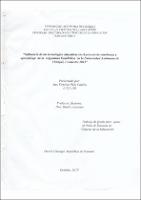"Influencia de las tecnologías educativas en el proceso de enseñanza y aprendizaje de la asignatura Estadística en la Universidad Autónoma de Chiriquí, I semestre 2015"
Abstract
La enseñanza se ha distinguido a través de los tiempos como un verdadero arte. En el nuevo escenario, tanto educativo como laboral, la tecnología se ha convertido en un recurso inherente; pues el siglo XXl lo exige. Los sistemas educativos en el nivel latinoamericano se enfrentan actualmente al desafío de utilizar las nuevas tecnologías. Las tecnológicas educativas han planteado nuevas líneas o perspectivas en el proceso educativo, contribuyendo al enriquecimiento de las clases dentro del aula. El uso de la tecnología en la Estadística, es una herramienta que juega un papel importante en el proceso de enseñanza aprendizaje. La presente investigación Analiza la influencia de las tecnológicas educativas en el proceso de enseñanza y aprendizaje en la asignatura de Estadística en la Universidad Autónoma de Chiriquí. Para ello el estudio tuvo origen en el departamento de Estadística de la Facultad de Economía, la cual cuenta con más de 35 años de funcionar en la Universidad. En el mismo laboran 13 docentes. El estudio fue descriptivo; ya que se identificaron características general es sobre el proceso de enseñanza-aprendizaje de la estadística. Además fue correlacional; ya que se determina cómo se relacionan o vinculan algunas variables entre sí. Se apoyó en un enfoque cuantitativo, ya que utilizo la recolección de datos para probar hipótesis, con base en la medición numérica y el análisis estadístico, para establecer patrones de comportamiento y probar teorías. El diseño de investigación de este estudio es no experimental. La información se obtuvo de fuentes primarias y secundarias. La población utilizada en la investigación es de 260 estudiantes en el 2015, en donde el tamaño de la muestra es de 158 encuestas para los estudiantes que recibieron un curso de estadística en el primer semestre del 2015, distribuidos de la siguiente forma: 96 en la Facultad de Administración de Empresas y Contabilidad, Facultad de Economía 32 y la Facultad de Administración Pública 29. La técnica de la encuesta será utilizada en este estudio a través de un cuestionario en donde habrá preguntas estructuradas de forma abierta, cerrada y otras en escala de Likert para evaluar la actitud de los estudiantes y docentes hacia el uso de la tecnología educativa en la enseñanza aprendizaje de la estadística. Además Se midieron 5 factores que fueron considerados dentro de la medición de las actitudes: Utilidad, Ansiedad, Confianza, Agrado y Motivación. También se realizaron Entrevistas personal a través de preguntas dirigidas al personal técnico del laboratorio de informática. La confiabilidad de la escalas de actitud se validaron a través deI Alfa de Cronbach, y la validación de los otros ítems en el instrumento fueron a través de una prueba piloto en el área de estudio o campo; en este caso, a una parte de los estudiantes de las diferentes licenciaturas. Para la validación del instrumento aplicado a los docentes se utiliza la técnica de juicios de expertos. Mediante el análisis de los datos recolectados, se logra determinar que la actitud del docente y el estudiante hacia el uso de la tecnología educativa en la enseñanza de la estadística es favorable. Teaching has distinguished itself through time as a true art. In a new scenario, both educational and work, technology has become an inherent resource because the 21st century demands it. Educational systems in Latin America are currently facing the challenge of using new technologies. The educational technologies have proposed new lines or perspectives in the educational process, contributing to the enrichment of the classes within the classroom. The use of technology in statistics is a tool that plays an important role in the teachingleaming process.
This research analyzes the influence of educational technology in the teaching and learning process in the subject of Statistics at Universidad Autónoma de Chiriquí. For this purpose, the study originated in the Department of Statistics of the Faculty of Economics, which has more than 35 years of functioning in the university. In it, 13 teachers work. The study was descriptive; since general characteristics were identified about the teaching-learning process of statistics. It was also correlational; since it is determined how some variables are related or linked to each other. It was based on a quantitative approach, since it was used data collection to test the hypotheses, based on numerical measurement and statistical analysis, to establish patters of behavior and to test theories. The research design of this study is non experimental.
The information was obtained from primary and secondary sources. The population used in the research is 260 students in 2015, and the sample size is 158 surveys for students who received a statistics course in the first semester of 2015, distributed as follows: 96 in the Faculty of Business Administration and Accounting, Faculty of Economics 32 and the Faculty of Public Administration 29. The survey technique will be used in this study through a questionnaire, where there will be questions structured in an opened, closed and others in the scale of Liken to assess the attitude of students and teachers towards the use of educational technology in the teaching of statistics. In addition, 5 factors that were considered within the measurement of attitudes were measured: Utility, Anxiety, Trust, Pleasure and Motivation. Personal interviews were also conducted through questions addressed to the technical staff of the computer lab.
The reliability of the attitude scales were validated through the Cronbach's Alpha, and the validation of the other items in the instrument were through a pilot test in the study area or field; in this case, to a part of the students of the different degrees. The technique of expert judgment is used to validate the instrument applied to teachers.
By analyzing the data collected, it is possible to determine that the attitude of the teacher and the student toward the use of educational technology in the teaching of statistics is favorable.

